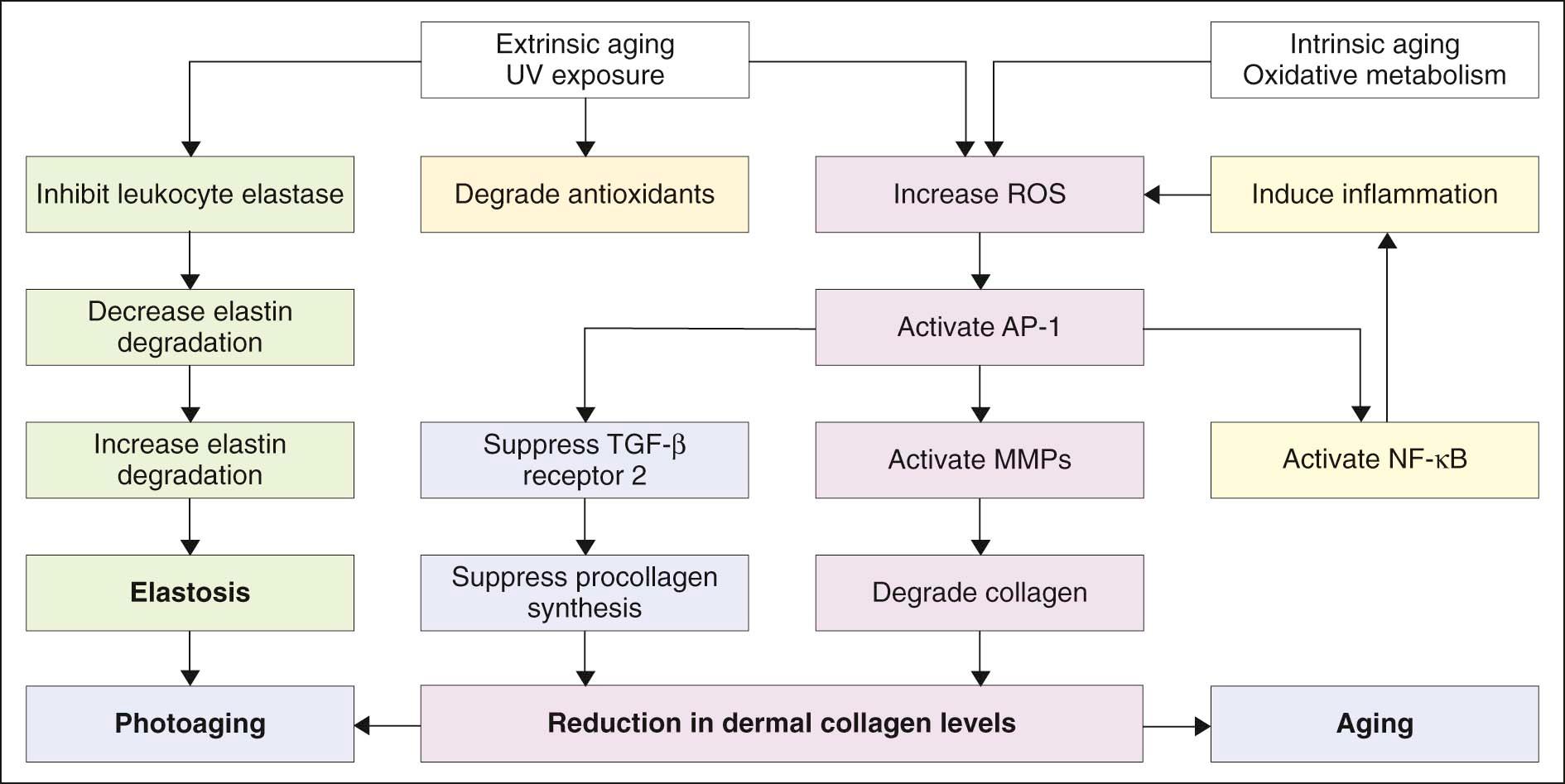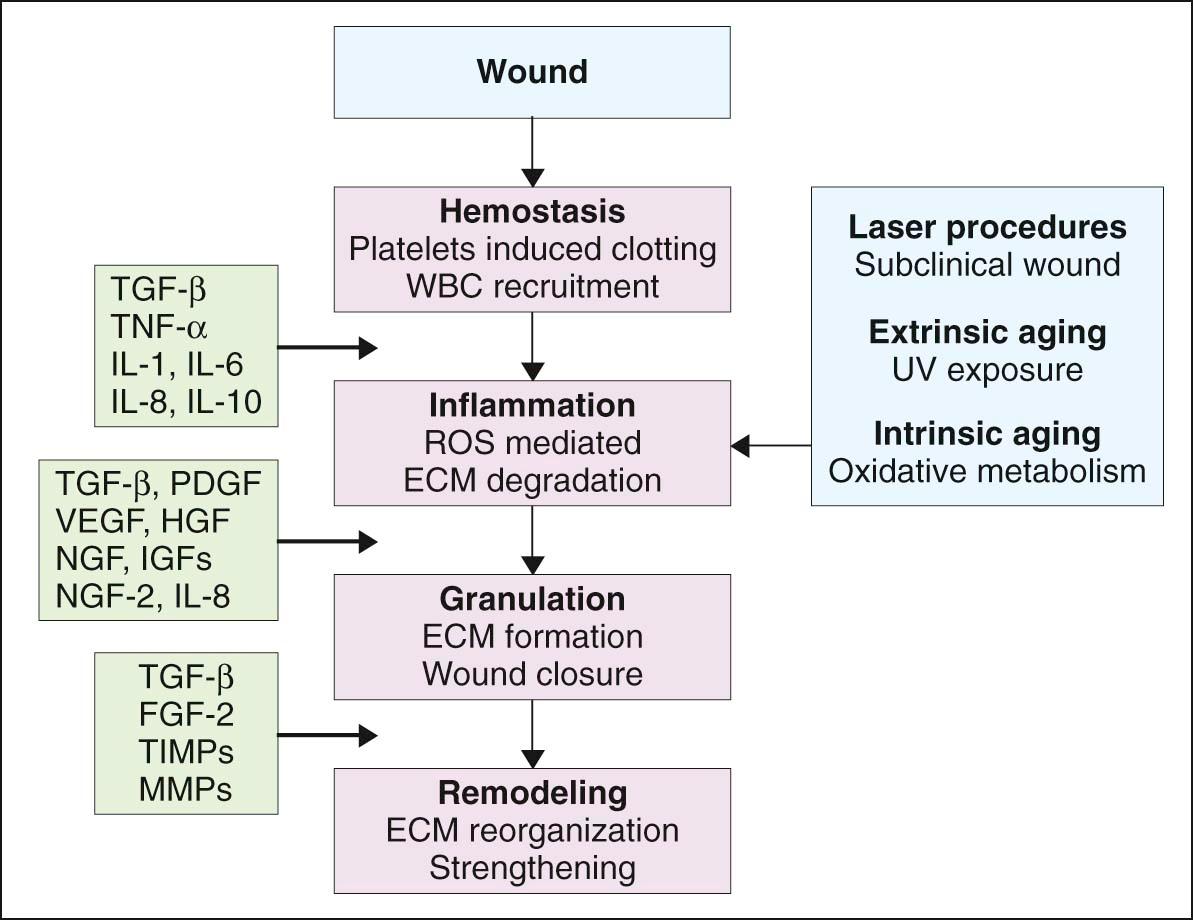Physical Address
304 North Cardinal St.
Dorchester Center, MA 02124
Growth factors play a major role in skin repair and regeneration
Topical application of growth factors alters expression of key extracellular matrix genes
Clinical evidence shows increased collagen production and decreased facial fine lines and wrinkles
Growth factors may be combined with other modalities of skin rejuvenation such as lasers and topical antioxidants
Growth factors must be stabilized in formulations to ensure efficacy when patients use the products
Exposure to ultraviolet (UV) radiation causes cumulative damage that accelerates normal chronologic aging and exacerbates injury to skin tissue, resulting in photodamage. Consumer interest in correcting signs of photodamage, such as wrinkles, dyspigmentation, sagging, and surface roughness, is increasing as the population ages, particularly as the ‘baby boomer’ segment reaches middle age. Treatments include topical retinoids and antioxidants, chemical peels, dermabrasion, laser, and various lifting surgeries, depending on the severity of skin damage.
Within the last decade researchers have focused on the pathophysiology of photodamage and have found correlations with certain aspects of acute and chronic wound healing. Of specific interest to cosmeceutical manufacturers are the effects of growth factors in the process of wound healing. Growth factors are regulatory proteins that mediate signaling pathways between and within cells. After a wound has been inflicted, a variety of growth factors flood the wound site and interact synergistically to initiate and coordinate each phase of wound healing. This process is complex and not completely understood. Most studies have evaluated the role of single growth factors in controlled wound-healing environments. These studies demonstrate the importance of growth factors in the repair of damaged tissue, but research into the phases of wound healing has demonstrated that it is the interaction of multiple growth factors that is vital to tissue regeneration. Cosmeceutical manufacturers have taken notice of the positive results of clinical studies showing accelerated wound healing and have begun to include growth factors in products designed to mitigate damage from chronologic aging and sun exposure.
Photodamage occurs predominantly within the epidermis and the upper papillary dermis. Histologic studies demonstrate that UV exposure disrupts the normal architecture of connective tissue within the dermis. The dermal extracellular matrix (ECM) is composed primarily of type I collagen, although type III collagen, elastin, proteoglycans, and fibronectin are also included in smaller amounts. UV exposure decreases collagen and elastin and alters the cross-linked structure of collagen and elastin fibers within the dermal ECM. Abnormal elastic material containing elastin and fibrillin accumulates and appears to occupy areas of lost collagen. This deposition of abnormal elastic material is called solar elastosis. Glycosaminoglycans (GAGs), a type of proteoglycan that is a component of the ECM, are polysaccharide molecules that bind to water, forming a hydrated, space-filling polymer between collagen and elastin fibers that helps support skin tissue. In photodamaged skin GAGs are abnormally deposited in the elastotic tissue rather than between collagen and elastin fibers. The clinical result of decreased collagen and elastin and disruption of the normal support architecture is the appearance of wrinkles, sagging skin, uneven pigmentation, hyperpigmentation, and thickened or leathery skin texture. Although chronologic aging skin also develops wrinkles, photodamaged skin is differentiated histologically by the presence of solar elastosis.
Research in the area of photoaging over the past decade has resulted in an improved understanding of the molecular mechanism of the aging process. Figure 16.1 shows a summary of major pathways involved in the aging process. Absorption of UV radiation by chromophores in the skin as well as cellular oxidative metabolism results in the formation of reactive oxygen species (ROS). ROS increase oxidative phosphorylation of cell-surface receptors causing activation of the transcription factor activator protein-1 (AP-1) and nuclear factor kappa B (NF-κB).

AP-1 stimulates transcription of matrix metalloproteinase (MMP) growth factor genes in fibroblasts and keratinocytes, and inhibits type 1 procollagen gene expression in fibroblasts. MMPs produce degradation of fibrillar type I and type III collagen. Activity of MMP is decreased by binding with tissue inhibitors of metalloproteinase (TIMPs). ROS inactivate TIMPs, thereby increasing MMP activity. AP-1 mediated reduction in synthesis of procollagen appears to result from two mechanisms – interference of AP-1 with type I and type III procollagen gene transcription and blocking the profibrotic effects of transforming growth factor-beta (TGF-β) by impairment of the TGF-β type 2 receptor/Smad pathway.
Activation of NF-κB stimulates transcription of proinflammatory cytokine genes including interleukin-1 (IL-1), TNF-α, IL-6, and IL-8. Inflammation resulting from these cytokines increases secretion of ROS and more cytokines, further enhancing the effect of UV exposure. Inflammation causes protease-mediated degradation of elastin and UV exposure causes formation of abnormal elastin by fibroblasts. UV light is also an inhibitor of leukocyte elastase, thereby increasing accumulation of elastotic materials. The accumulation of elastotic materials is accompanied by degeneration of the surrounding collagenous network.
The overall effects of these interlinked biochemical activities is reduction of procollagen synthesis, increase of collagen degradation in the dermal ECM, and increase in irregular elastin deposition.
Hundreds of growth factors have been identified in skin. Those that are important in wound healing include cytokines involved in immune response and phagocytosis, and growth factors that induce the synthesis of new collagen, elastin, and GAGs (components of the dermal ECM) that are abnormally affected by UV radiation. Table 16.1 lists the functions of the most important growth factors in wound healing.
| Growth factors and cytokines | Properties/actions |
|---|---|
| Vascular endothelial growth factor (VEGF) | Mediates angiogenesis Chemotactic for endothelial cells Mitogenic for endothelial cells and keratinocytes |
| Hepatocyte growth factor (HGF) | Mediates tissue organization and regeneration |
| Platelet-derived growth factor (PDGF) | Chemotactic for fibroblasts and macrophages Mitogenic for fibroblasts, smooth muscle cells, and endothelial cells |
| Epidermal growth factor (EGF) | Mediates angiogenesis Chemotactic for endothelial cells Mitogenic for fibroblasts, endothelial cells, and keratinocytes |
| Granulocyte colony stimulating factor (G-CSF) | Mediates angiogenesis Mitogenic for hematopoietic cells |
| Transforming growth factor-beta (TGF-β) | Mediates angiogenesis Chemotactic for fibroblasts, keratinocytes, and macrophages Mitogenic for fibroblasts and smooth muscle cells Inhibits endothelial cells, keratinocytes, and lymphocytes Regulates matrix proteins including collagen, proteoglycans, fibronectin, and matrix-degrading proteins |
| Keratinocyte growth factor | Mediates tissue organization and regeneration |
| Interleukins (IL-6 and IL-8) | Chemotactic for inflammatory cells and keratinocytes Mitogenic for lymphocytes and keratinocytes |
Wound healing is dependent on the synergistic interaction of many growth factors. After injury, cytokines and other growth factors flood the wound site to mediate the inflammatory response, promote new cell growth, and decrease wound contraction and scarring. The process of wound healing is commonly divided into four overlapping phases that describe physiologic responses to injury. These phases include hemostasis, inflammation, proliferation, and remodeling. Figure 16.2 summarizes each phase of wound healing along with dominant growth factors and cytokines. During hemostasis, platelets release various cytokines and other growth factors at the wound site to promote chemotaxis and mitogenesis. In the inflammatory stage, neutrophils and monocytes migrate to the wound site in response to specific cytokines and growth factors to initiate phagocytosis and to release additional growth factors that will attract fibroblasts. The proliferation phase is marked by epithelialization, angiogenesis, granular tissue formation, and collagen deposition. During proliferation, keratinocytes restore barrier function to the skin and secrete additional growth factors that stimulate the expression of new keratin proteins. Fibroblasts produce collagen that is deposited in the wound bed. This cycle of collagen production and growth factor secretion continues in a type of autocrine feedback loop of continuous wound repair.

The remodeling phase is the final step in the wound repair process and typically lasts several months. It is during remodeling that the ECM is reorganized, scar tissue is formed, and the wound is strengthened. Type III collagen deposited during the proliferation phase is gradually replaced by type I collagen, which is more tightly cross-linked and provides more tensile strength to the matrix than type III collagen. Cells at the wound site secrete several growth factors with specific functions related to remodeling and matrix formation. For example, collagen and fibronectin synthesis are initiated by TGF-β, while PDGF and TGF-β stimulate fibroblasts to produce GAGs and modulate the proliferation of smooth muscle cells. Other growth factors modify the vasculature. Over time, cell density increases and skin tissue is strengthened.
Specific growth factors directly initiate activity that promotes wound healing as well as modifying the activities of matrix cells and other growth factors. Growth factors are capable of both stimulating and inhibiting specific actions. The activity of growth factors is modulated through other growth factors and through various intrinsic factors that interact to achieve homeostasis and balance during wound healing. Research continues to uncover more information about the functions of individual growth factors during wound healing and, importantly, the synergistic interaction of growth factors with each other and with other components of wound healing. Whether the presence or absence of a single growth factor is significant in wound healing is not yet known. Current understanding suggests that it is the interaction of many growth factors that is significant, with no single growth factor being solely determinant in the outcome of wound healing.
Become a Clinical Tree membership for Full access and enjoy Unlimited articles
If you are a member. Log in here